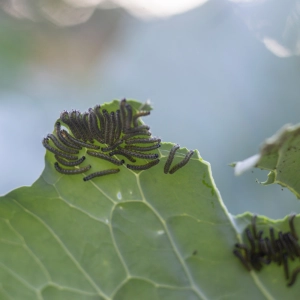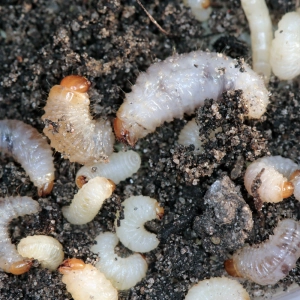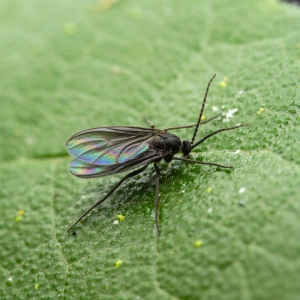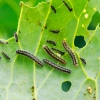
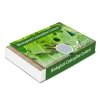


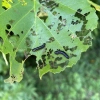
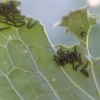
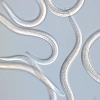

Caterpillar Control
- PLEASE NOTE: All live predator products will take up to 7 working days to arrive.
- Controls most species of caterpillars.
- Will also control bank flies.
- Kills prey by secretion of bacteria.
- Suitable for use in organic gardens – chemical free.
- 100% safe for children, pets, earthworms, bees and birds.
- Easy to apply with a watering can – no expensive equipment needed.
- Zero harvest interval – edible crops can be treated and eaten immediately.
Full Description
Caterpillars grow from the eggs of butterflies and moths and can cause real damage to garden plants and crops.
Brassicas, nasturtiums, and cauliflowers are loved by cabbage white caterpillars, but many other caterpillar species have an equally enormous feeding capacity, often skeletonising the leaves of vegetable plants, trees and ornamentals overnight.
Stems, flowers, fruits, leaves and growing tips can all be destroyed by a batch of hungry caterpillars, causing aesthetic damage, and at times complete plant loss.
Spotting Caterpillar Damage
Holes in leaves, skeletonised leaves, and window effect leaves (where small caterpillars graze or mine the underside of leaves leaving the upper layer of the leaf surface intact) are the main indicators of caterpillar presence.
Caterpillars can deposit large quantities of frass as they move across plants which can be another indicator of activity.
What is Biological Caterpillar Control?
Biological controls are non-chemical treatments that rely on the natural enemies of pests. In the case of caterpillar control, the enemy is the nematode, specifically, the species Steinernema sp.
Steinernema sp. are UK native microscopic worms that actively seek out a variety of caterpillars, feeding and multiplying inside them, then infecting them with a bacterium. Once infected, the caterpillars will stop feeding and die. The nematode will then leave the dead caterpillar and go on to seek out more, repeating the cycle.
Biological caterpillar control is a highly effective, safe treatment that can be used on all edible crops and ornamentals – both as a soil drench and as a foliar spray. They are safe for pets and other wildlife and the perfect choice for organic gardeners.
How Many Nematodes Do I Need?
We sell biological caterpillar control in packs that cover the following areas:
- 60m2
- 100m2
- 500m2
There are millions of microscopic nematodes in each pack – carefully worked out to ensure accurate application for each specific area listed. Each application of nematodes will provide at least six weeks control of caterpillars.
Nematodes are supplied as an easy-to-mix powder which needs to be diluted with water before use. Specific dilution rates are shown in the table below.
Storage
- After delivery, please check the product for abnormalities and report any issues to Agrigem within 24 hours.
- As this product is perishable, it is preferable to use immediately after receipt. If not applying the same day, this will need to be refrigerated and used within two days.
- To store in refrigerated conditions, please remove the outer packaging to ensure good air circulation around the tray(s).
- If the product is stored longer and/or differently to the above, Agrigem will not be liable for loss of quality.
- Use the entire pack and do not store stock solution or diluted product.
Application
|
Pack Size |
Dilution Rate |
Application Instructions |
|
60m2 |
1 pack of nematodes fills 8 watering cans or 8 sprayers with 5 litres of water to treat 60m2 or 16 trees in 40L of water. |
For a soil drench - Wet soil before application. Dissolve the entire contents of the pack in a bucket containing 4L of water to create a stock solution. Stir vigorously.
Take out 500ml of the stock solution and add to a watering can with 4.5L of water. Apply this solution as a soil drench to cover 7.5m2. Repeat these steps until all of the stock solution has been used and 60m2 have been treated.
For a foliar spray - Wet foliage before application. Dissolve the entire contents of the pack in a bucket containing 4L of water to create a stock solution. Stir vigorously.
Take out 500ml of the stock solution and add to an empty pump sprayer with 4.5L of water. Apply this as a foliar spray to an eighth of the area.
Repeat these steps until all of the stock solution has been used and 60m2 have been treated. |
|
100m2 |
1 pack of nematodes fills 10 large watering cans with 10L of water to treat 100m2 or 5 large sprayers with 20L of water. |
For a soil drench - Wet foliage before application. Dissolve the entire contents of the pack in a bucket containing 10L of water to create a stock solution. Stir vigorously.
Take out 1L of the stock solution and add to a watering can with 9L of water. Apply this solution as a soil drench to cover 10m2.
Repeat these steps until all of the stock solution has been used and 100m2 have been treated.
For a foliar spray - Wet foliage before application. Remove fine filters from sprayer. Dissolve the entire contents of the pack in a bucket containing 10L of water to create a stock solution. Stir vigorously.
Take out 2L of the stock solution and add to an empty pump sprayer with 18L of water. Apply this as a foliar spray to 25m2 of the area.
Repeat these steps until all of the stock solution has been used and 100m2 have been treated. |
|
500m2 |
1 pack of nematodes fills 50 large watering cans with 10L of water to treat 500m2 or 25 large sprayers with 20L of water.
|
For a soil drench - Wet foliage before application. Dissolve the entire contents of the pack in a bucket containing 20L of water to create a stock solution. Stir vigorously.
Take out 400ml of the stock solution and add to a watering can with 9.5L of water. Apply this solution as a soil drench to cover 10m2. Repeat these steps until all of the stock solution has been used and 500m2 have been treated.
For a foliar spray - Wet foliage before application. Remove fine filters from sprayer. Dissolve the entire contents of the pack in a bucket containing 20L of water to create a stock solution. Stir vigorously.
Take out 800ml of the stock solution and add to an empty pump sprayer with 19L of water. Apply this as a foliar spray to 25m2 of the area.
Repeat these steps until all of the stock solution has been used and 500m2 have been treated. |
Our Recommendation
When to Apply Biological Caterpillar Control
You can apply nematodes when the soil temperature is above 12°C (for soil application) and the air temperature is above 14°C for foliar application. A second application may be required 6-8 weeks later.
Nematodes are particularly effective in damp, wet weather. Try and choose a humid or wet day to apply the nematodes. They are UV-sensitive so it is best to avoid applying them on a bright sunny day as they will not survive in these conditions. The best humidity levels are often found first thing in the morning or late afternoon
How to Apply Biological Caterpillar Control
Apply to moist compost/soil, when the soil temp is above 12ºC using a watering can or sprayer.
- Do not apply in sunny weather as nematodes are UV sensitive.
- If applying to foliage, ensure the leaves have been wet for at least two hours.
- Ensure you apply to moist soil using a watering can or sprayer. Remove any filters before use and follow the diluting and application instructions above.
- Avoid over watering the area after application, keep lightly moist.
- If the pest problem is already well established this may take multiple applications a few weeks apart.
- Water the soil thoroughly after application to wash the nematodes into the soil and keep the soil moist for at least two weeks after application.
- For further advice or guidance contact our specialists on 01522 246491.
Technical Specification
| Product | Caterpillar Control |
|---|---|
| Brand | |
| Period Of Use | Autumn, Summer |
| Active Ingredient | Steinernema sp. |
| Application Method | Watering Can, Knapsack |
| Pack Size Coverage | Up to 500m² |




